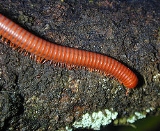
Millipede
Overview
Millipedes are arthropod
s that have two pairs of legs
per segment (except for the first segment behind the head which does not have any appendage
s at all, and the next few which only have one pair of legs). Each segment that has two pairs of legs is a result of two single segments fused together as one. Most millipedes have very elongated cylindrical bodies, although some are flattened dorso-ventrally, while pill millipede
s are shorter and can roll into a ball, like a pillbug
.
The name "millipede" is a compound word formed from the Latin
roots ("thousand") and ("foot").
Arthropod
An arthropod is an invertebrate animal having an exoskeleton , a segmented body, and jointed appendages. Arthropods are members of the phylum Arthropoda , and include the insects, arachnids, crustaceans, and others...
s that have two pairs of legs
Arthropod leg
The arthropod leg is a form of jointed appendage of arthropods, usually used for walking. Many of the terms used for arthropod leg segments are of Latin origin, and may be confused with terms for bones: coxa , trochanter , femur, tibia, tarsus, ischium, metatarsus, carpus, dactylus ,...
per segment (except for the first segment behind the head which does not have any appendage
Appendage
In invertebrate biology, an appendage is an external body part, or natural prolongation, that protrudes from an organism's body . It is a general term that covers any of the homologous body parts that may extend from a body segment...
s at all, and the next few which only have one pair of legs). Each segment that has two pairs of legs is a result of two single segments fused together as one. Most millipedes have very elongated cylindrical bodies, although some are flattened dorso-ventrally, while pill millipede
Pill millipede
Pill millipedes make up two orders of millipedes, often grouped together into a single superorder, Oniscomorpha. The name Oniscomorpha refers to the resemblance of pill millipedes to certain woodlice, namely the pillbugs of the family Armadillidiidae, also called "potato bugs", "doodlebugs", or...
s are shorter and can roll into a ball, like a pillbug
Armadillidiidae
Armadillidiidae is a family of woodlice, a terrestrial crustacean group in the order Isopoda. Unlike members of other woodlouse families, members of this family can roll into a ball, an ability they share with the outwardly similar but unrelated pill millipedes and other animals...
.
The name "millipede" is a compound word formed from the Latin
Latin
Latin is an Italic language originally spoken in Latium and Ancient Rome. It, along with most European languages, is a descendant of the ancient Proto-Indo-European language. Although it is considered a dead language, a number of scholars and members of the Christian clergy speak it fluently, and...
roots ("thousand") and ("foot").
Unanswered Questions
Discussions

